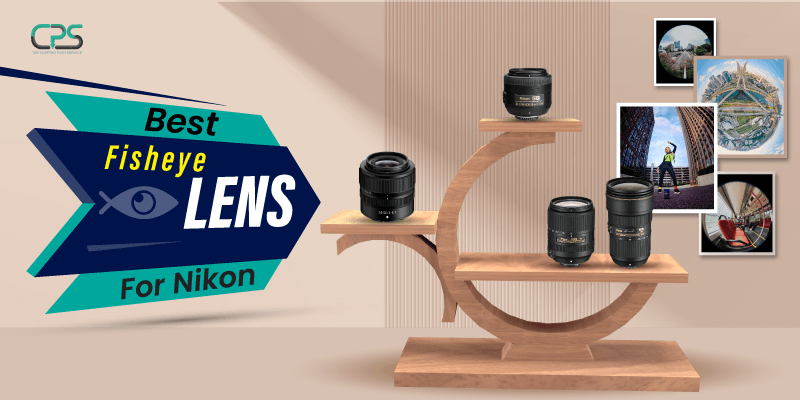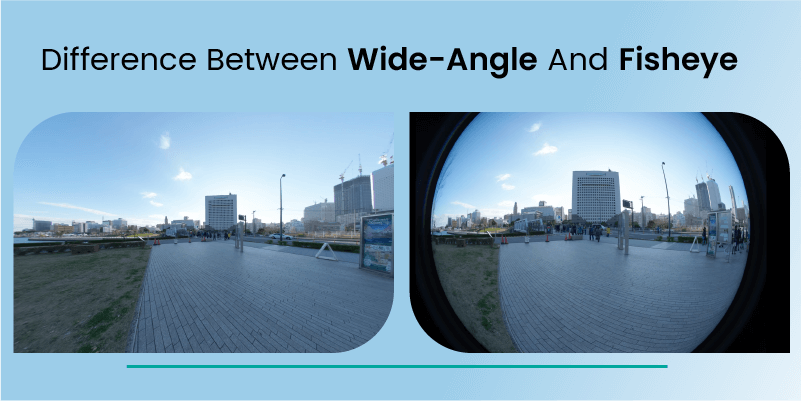
9 Of The Best Fisheye Lenses For Nikon
Whether it’s sports or night sky photography, fisheye lenses work great all the time. But, finding out the best fisheye lens for Nikon camera gear might seem tricky. So, to make things easier, we have sorted out the top chart of the best lenses you can choose. It’s simple and easy to understand.
Also, you will get an in-depth guideline on which fisheye lens to use along with the list. However, not all fisheye lenses have the same characteristics, so you must choose the best one possible.
Moreover, when you choose the perfect fisheye lens, you get the signature 180-degree rounded images with ease. It looks distorting yet amazing as if we are seeing the photo through a fisheye.
Table of Contents
ToggleExplaining Fisheye Lens
In simpler terms, a fisheye lens provides us with a wide-angle shoot that creates 180-degree wide-angle images. The “Fish-eye” term comes from Robert W. Wood. According to him, that’s how a fish gets to see from underneath the water. However, the actual Fish-eye lens first came into production in the 1960s.
Right after its first release, the fisheye lens became widely used in countless industries. For example, it’s hugely popular in science, astronomy, sports, videography, and so on. The popularity grew a lot higher with the introduction of the 90s pop culture.
Currently, you have plenty of fisheye lenses to choose from to create distorted panoramic images. Most of them work great to provide accurate 180-degree distortion.
List of 9 Best Fisheye Lens For Nikon
Let’s explore the finest fisheye lens for Nikon and get to know about each of the products. Reading out each of the analyses will give you a better chance of getting the perfect product.
1. Sigma 15mm f/2.8 EX DG Diagonal Fisheye Lens
You must check out the following lens when looking for the best fisheye lens. It would provide you with the perfect 180-degree view possible. Plus, it would provide you with the gelatin filter holder which is of the highest quality. In addition, the autofocus is up to the mark as well.
As a result, you get great fish eye distortion on the image you capture. Moreover, to save the lens from outside dirt and dust, you have a protective lens cap on the following kit. So you could get onto the street and start creating a photography album without worrying about damaging your lens.
It’s fantastic to use and provides great effects without any issue at all. To be specific, using the following lens kit on professional projects would be a lot easier than ever.
Creating closeup photography is easy on the lens, and you don’t have to configure settings with regular intervals at all.
Pros
- Nikon F (FX) Compatible
- Offers digitally optimized images
- Superior auto-focus
- Digitally optimized images
Cons
- AF doesn’t work in LiveView mode.
2. Sigma 4.5mm f/2.8 EX DC HSM Circular Fisheye Lens
Looking for a perfect solution to capture low light photography with a fisheye effect? Look no further. Because now, we are presenting you with the Sigma 4.5mm Circular Fisheye Lens.
On the following lens, you get top-class distortion, creating a unique perspective. In addition, the lens’s compatibility is on the spot, as it works great with Nikon DX series cameras.
Doing manual focus override on the following lens helps you keep the subject in the right focus. It ensures you get total ease when doing your photography projects without any issues.
With 180 degrees of distortion, you get to capture the perfect fisheye photos. Perhaps, each photo would be consistent in distortion, providing a unifying vibe to your album. So make sure you check out the lens for your project.
Pros
- Super fast autofocus
- Works great with non-full frame cameras
- Super fast autofocus
- Proper wide angle operation
- Suitable to capture equirectangular panoramas
Cons
- Getting proper depth of field is a bit tricky.
3. Rokinon 12mm F2.8 Ultra Wide Fisheye Lens
Now comes the Rokinon 12mm F2.8 Ultra Wide Fisheye Lens. The following lens has the best features to create 360 images on the go. In addition, it’s simpler and easy to use than most Nikon FX cameras.
The lens construction consists of 12 glass elements. As a result, the image will include actual image distortion to create the fisheye images.
On the other hand, an aperture of f2.8 – f22 will provide you with the perfect setup to go for close-up photos. As a result, you can capture wide-angle images without any issues. The light will be equal throughout the frame.
Images of the lens are sharp and vibrant to go on. Your fisheye photos would be much more consistent as each of the parameters of the image is almost the same.
This is why you should check out the following lens kit and get a proper Fisheye image that looks stunning from all perspectives.
Pros
- Robus lens buildup
- Has Ultra Multi Coating
- useful for architecture photos
- Easy to create 360 Degree virtual tours
- affordable Fisheye lens kit
Cons
- Don’t offer an AF feature.
4. Rokinon HD8M-N 8mm f/3.5 HD Fisheye Lens
Do you love to get HD fisheye images? The following lens, Rokinon HD8M-N 8mm f/3.5 HD Fisheye Lens, will provide you with the best possible image quality. In addition, the following lens is suitable for providing sharper images.
For proper protection, the lens has an Ultra multi-coating. Perhaps, you could go to different places and not have any kind of damage on the lens at all. It would ensure you keep working on your projects without any issues.
In addition, visual distortion of the lens provides you with the perfect effects you crave. You don’t have to dig deep into the settings of the lens to get a better perspective.
You could keep the glare in control with the lens hood within the lens unit. But, overall, it’s worth having the following lens to create fisheye effects.
Pros
- Anti-glare system
- Nano coating
- The lower amount of coma
- Petal Shaped lens hood
- 6 Diaphragm lens blades
Cons
- Don’t have a zooming feature.
5. Altura Photo 8mm f/3.0 Professional for Nikon
When you love creating amazing landscape images, you should check out the following lens. It’s called the Altura Photo 8mm f/3.0 Wide Angle Lens Aspherical Fisheye Lens. Whether you believe it or not.
For protection, the lens kit features a custom carrying case. The shape of the lens case is created especially for the lens unit. Hence, you won’t need additional space while traveling while carrying the lens.
Talking about the aperture count, it features f/3.0-f/22. Perhaps, it’s the best possible setting to let you create close-up yet wide range fisheye shoots. In addition, the internal settings of the lens provide total ease to change the settings and get a perfect shot right away.
So, you must check out the following lens kit if you plan to do it professionally. The unit provides a bag, lens cap, hood, case, and other accessories as a bonus.
Pros
- Provide precise manual focus
- Multilayer protective lens coatings
- Has advanced optics
- Perfect partner controlling
Cons
- Does Not work with the Autofocus feature
The mentioned dynamic lens unit is the JINTU 8mm F/3.0 Professional Wide Angle Fisheye Lens. It works great for Nikon lenses with the exponential Nikon F mounting capabilities.
Capturing photos with close-range photoshoots is great with the following lens unit. Even if you are closer to a specific object, the whole landscape would be in the film. It makes the unit great for shooting architecture photos.
Unlike any ordinary fisheye lens, you won’t get any flare on your images. We even tested it out in low-light conditions, and each photo turned out great.
But what makes us skeptical is that the lens doesn’t include image stabilization features. This is why You must be a bit alert when taking photos.
Besides image stabilization, the lens is great for any pro-level projects.
Pros
- Smoother manual focusing
- Offer metal connect mount
- Has advanced aspherical glass
- Affordable pricing range
- Provides a large viewing angle
Cons
- The camera mood must be in M-mood.
7. Nikon AF-S DX NIKKOR 35mm f/1.8G Lens with Auto Focus
Among the compact fisheye lenses, the Nikon AF-S DX NIKKOR 35mm f/1.8G Len is the best. Its lighter weight makes it great to travel with. In fact, you won’t feel any hurdles while taking photos with your hands.
In addition, the low light performance of the lens is great. As a result, the photos would be sublime to view, even in tricky places with scarce lighting.
Even if most fisheye lens does not include auto-focus features, the following lens has it for you. It would provide you the total ease when it comes to shooting several images on the go.
You have the option to create bokeh effects as well. The bokeh effect blurs the background making the subject appear in the spotlight.
Pros
- Great for traveling
- Super fast autofocus
- Outstanding bokeh effects
- Professional image quality
- Has silent web motor
Cons
- Does not offer a zooming feature
8. MEKE 8mm f3.5 Ultra Wide Angle Fisheye Lens
When you are looking for a robust lens with a manual focusing feature, the following lens can greatly help you. Perhaps, the following kit is named the MEKE 8mm f3.5 Ultra Wide Angle Manual Focus Rectangle Fisheye lens.
In the following lens kit, you get the f3.5 – f22 aperture range which is great for creating fisheye lenses. In addition, it has full capability to create perfect 180° images. Moreover, the following lens would be a perfect fit for you if you are doing fisheye imaging as a professional.
Even if you are wondering about the capabilities, the following lens works great with all Nikon APS-C cameras. Apart from that, the lens can also work with full-frame camera kits.
The lens kit offers you a lens hood to avoid overexposure as well. The lens hood is sturdy and lightweight at the same time.
Pros
- Works with full frame camera
- Perfect aperture control
- Lightweight lens
- Anti-glare lens coating
- Has nine aperture blade
Cons
- Don’t have a zooming feature
9. Vivitar 8mm Ultra-Wide f/3.5 Fisheye Lens For Nikon
In the following section, we are reviewing the Vivitar 8mm Ultra-Wide f/3.5 Fisheye Lens For Nikon. Don’t go for the number, as it’s one of the great lenses to use. It’s one of the affordable lens units which you could use in your hobby or professional projects.
Like any other quality lens unit, the following unit provides Aspherical Lenses. These kinds of lenses are great for creating fisheye projection.
Going on to the maximum focal length of the lens, it’s 8 Millimeters. Moreover, it consists of all the mechanisms to provide you with top-notch images right away.
Overall it’s a great lens to put your hands on. Letting you carry out your hobby or professional-level projects would be fine.
Pros
- Provides you with the sharpest images
- Higher compatibility
- Comes with a carrying pouch
- 167° diagonal field-of-view
- Provides dramatic effects
Cons
- The lens cover is a bit tricky to pace in.
What's The Difference Between Wide-Angle And Fisheye?

Even though the fisheye lens falls under the wide-angle lens category, not all wide-angle lenses are fish-eye lenses. On the other hand, talking about the kinds of lenses available they both have huge distinctions.
The fish eye lenses have 2 kinds on their own. These are:
- Full-Frame Fisheye
- Circular Fisheye
The wide-angle lens has three kinds within its specifications. These are:
- Wide Angle
- Ultra wide angle
- Fisheye
When it comes to the end result of both cameras, ordinary wide-angle cameras don’t provide full circular images. But on the other hand, fish-eye offers you full-circular images aka full-frame images. Both are famous in different fields. Wide angle lenses are great for filming landscapes and fish-eye are great for astronomy, sports, and other fields.
What to Look Before Buying Fisheye Lenses
Let’s look at the points you must review before buying a brand new fisheye lens. Doing so will give you the directions on which lens you should pick up. These aren’t rocket science, only some general aspects of the lens.
Distortion Quality
As we buy out the fisheye lens, the distortion quality matters greatly. Unfortunately, not all kinds of lenses provide you with the perfect 180-degree circular distortion on the image, which is why it’s crucial to review the distortion quality of the image. You could review some of the photos of the specific lens.
However, you will sense the 180-degree curve with a circular distortion at the two sides of the image. If the lens is not providing the perfect distortion you are looking for, look for another lens kit because faulty lenses will not provide you with proper distortion at any cost.
Portability
Are you working on freelance architectural photography projects? Then it’s better to have a lightweight lens that is easier to carry. In addition, it’s better when you have some sort of case or pouch to carry along. That’s why you should also look at the weight of any specific lens.
On the other hand, when you are working on projects where moving is not mandatory, go for robust ones. The lens weight becomes irrelevant as you don’t have to move from place to place. Again, it depends on your projects and how you’re configuring your gears.
Glare Protection
As most photographers, you will probably work outdoors. Unfortunately, light can damage your photos while you are capturing these huge architectural monuments. Effects such as glare can spoil your fisheye photography projects. The lens must have a protective coating to save your photos from glare.
This protective coating on the surface of the lens protects your images from errors such as glare and flare. Moreover, these protective layers prevent the dust and water from sitting and becoming permanent on the lens surface, which is why you need to check whether the lens has protective layers.
Camera Compatibility
Checking out the compatibility of the lens is a must. Without proper capability support, you won’t be able to install it on your cameras. That’s why you must read out for the compatibility of the lens. Of course, you could also inspect the list that comes along with any lens kit.
For example, the Vivitar 8mm Ultra-Wide lens is compatible with the Nikon F camera series. If you have to use the following lens, only the specific camera set.
Let’s look at some questions you might want to know more about.
What Is A Fisheye Lens Used For?
The fisheye lens is useful to create extremely distorted images. Plus, each of the distortions is consistent and aesthetics as well. In addition, fisheye lenses are great for capturing a wider landscape within short distances. All in all, it’s a great option for any landscape and architectural photographer.
What Is A Full-Frame Fisheye Lens?
The full-frame fisheye lens provides a circular-shaped image that captures the full frame at once. These lenses are great to capture a roundish 180-degree image that looks unique all the time, which is why you should check out the “full-frame” mode photos of a specific lens.
What Is Focal Length Considered Fisheye?
A focal length of 8mm to 10mm is called a fisheye lens. Hence, anything longer than that will be considered a full-frame lens. In addition, our mentioned list of lenses does have a focal length within the 10mm threshold.
Conclusion
Having the best fisheye lens for Nikon camera lenses will be a huge advantage for any photographer. Perhaps, you should always use the best camera lens for your fisheye photography projects. Whether a hobby or a professional task, it’s a must most of the time.
Ultimately, we suggest you upgrade your gear if it has become old. Upgrading your lenses and getting new ones will provide you with the perfect fisheye photos. Be sure to check each of the lenses and choose the ones which will suit you the best.

Bordie Capron
Author
“Bordie Capron is a Sr. Content Maker who is working in The Clipping Path Service an US-based image and video post-production company for over 7+ years. She completed her degree in graphic designing and worked as a graphic designing expert for several years. She always loved writing”
Categories
- Image Guidelines (12)
- Post Production (8)
- Pre Production (27)
- Review (16)
- Tips (51)
- Tutorial (18)
Recent Posts
Quick Response
Email:
cs@theclippingpathservice.com
Hotline Support:
Mobile: +1 (718) 717-2362











No Comments